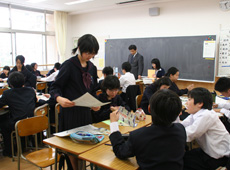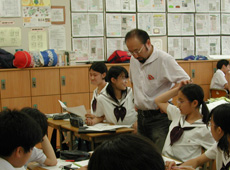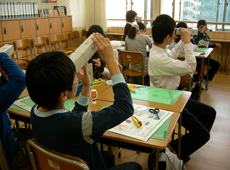Q. What motivated you to start a space education program?

A class to think about the environment of Chiyoda-ku, where the school is located. (Supported by Mitsubishi Estate Co., Ltd.)

A wall newspaper with a collection of suggestions
My initial inspiration was a story about Hikari Plaza in Kokubunji district, Tokyo, where its science class adopted a space education curriculum. I wanted our students to be able to have a similar experience as me, so I contacted JAXA. I also heard about a space education program in Kagoshima, which focused on leading a totally recycling-based lifestyle. For example, I heard that the children suggested that they should use burdock roots as skewers for Yakitori (grilled chicken) to avoid waste when cooking, which I thought was wonderful.
The most important thing in education is to instill in the children dreams, motivation and a can-do spirit. I thought space education could do that. I think space inspires children's motivation.
Q. What kind of feedback have you had from students and parents since the space education program began?
Usually, when you talk about putting our environmental concerns into practice, many children make suggestions about how to reduce garbage, limit electricity use, etc. Such a "think local" approach is important, but it seems rather small in scale. Three years ago, that was the extent of the ideas coming from most of our students. However, since we adopted space education and the students started hearing stories of life in space, they've developed ambitious dreams for space technology. For example, a student in the first year of middle school came up with the idea of a "food producing machine," which would process food scraps and human excrement into food. After we brought in space education, the kinds of ideas the children came up with changed drastically. We give students opportunities to present their ideas, in such as school cultural festivals or other environment-themed events, and the parents are just astonished by the results.
The "food producing machine" idea was presented by a group of four students in their first year of middle school, when a JAXA lecturer was visiting out class. After several classes, the student who had struggled with group work at the beginning managed to summarize the group's work quite well, and started posing questions directly to the lecturer. Our cooperation with JAXA allows us to hold these Q&As during class. The students have the opportunity to ask many questions, and the class is very active. I think getting information this way, directly from the source, helps reinforce the huge changes that are happening in these children's thinking.
Courtesy: Kudan Secondary School, Chiyoda-ku


